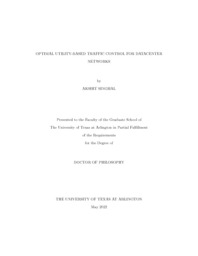| dc.description.abstract | As datacenter applications with diverse service requirements proliferate, it becomes imperative to enable datacenter network flow rate allocation that satisfies minimum user-utility requirements, while allowing for user-utility-based fair resource allocation. Multiple Path Transmission Control Protocols (MPTCPs) allow flows to explore path diversity of datacenter networks and multihoming to improve throughput, reliability, and network resource utilization. The work in this dissertation aims to develop optimal utility-based datacenter traffic control protocols to meet diverse service requirements for datacenter applications.
Specifically, this dissertation makes contributions on four highly related research topics. First, we put forward a HOListic traffic control framework for datacenter NETworks (HOLNET) that reformulates the network utility maximization (NUM) framework into a HOLNET NUM framework that fully harnesses the potential of the existing NUM-based solutions to allow large families of traffic control protocols of various degrees of sophistication to be developed, i.e., host-based, single or multiple Class-of-Service (CoS) enabled, single or multi-path congestion control, with or without in-network load balancing. Case studies, based on both a single and a multi-path host-based solutions, demonstrate the viability and flexibility in HOLNET design space exploration. To further test the backward compatibility and performance with respect to some existing lightweight solutions, we develop HOLNET-UTA, an integrated congestion control and load balancing protocol, achieving TCP-fair resource allocation. HOLNET-UTA is found by simulation to improve the average flow completion time (FCT) by more than 20%, compared to DRILL [1] with DCTCP [2].
Second, we derive and implement in Linux kernels two distinct families of NUM-optimal MPTCP protocols, EUTCP(γ), a function of a rate-scaling vector of the sub-flow rate-scaling coefficients, γ, and WUTCP(ω), a function of a utility weight vector of the sub-flow weights, ω, respectively. While the former allows resource pooling, the latter does not. The performance of the two families with equal weight and equal rate-scaling coefficient for all sub-flows when coexisting with TCP is also analyzed based on experiments in a testbed
Third, we propose a Hybrid MPTCP (H-MPTCP) with a built-in mechanism to incentivize users to use multiple paths with different pricing structures. In the meantime, H-MPTCP preserves the nice properties enjoyed by the state-of-the-art MPTCP solutions. Extensive real Linux implementation results verify that H-MPTCP can indeed achieve the design objectives.
Finally, we revisit a state-of-the-art datacenter traffic control protocol, known as datacenter TCP (DCTP) [2]. DCTCP is empirically designed and hence, does not have a specific global design objective in mind. In this research, we prove that with a simple modification of the congestion indicator, DCTCP can be turned into a NUM-optimal traffic control protocol. | |


